fuel cap YAMAHA FX HO CRUISER 2018 Owners Manual
[x] Cancel search | Manufacturer: YAMAHA, Model Year: 2018, Model line: FX HO CRUISER, Model: YAMAHA FX HO CRUISER 2018Pages: 116, PDF Size: 4.84 MB
Page 27 of 116
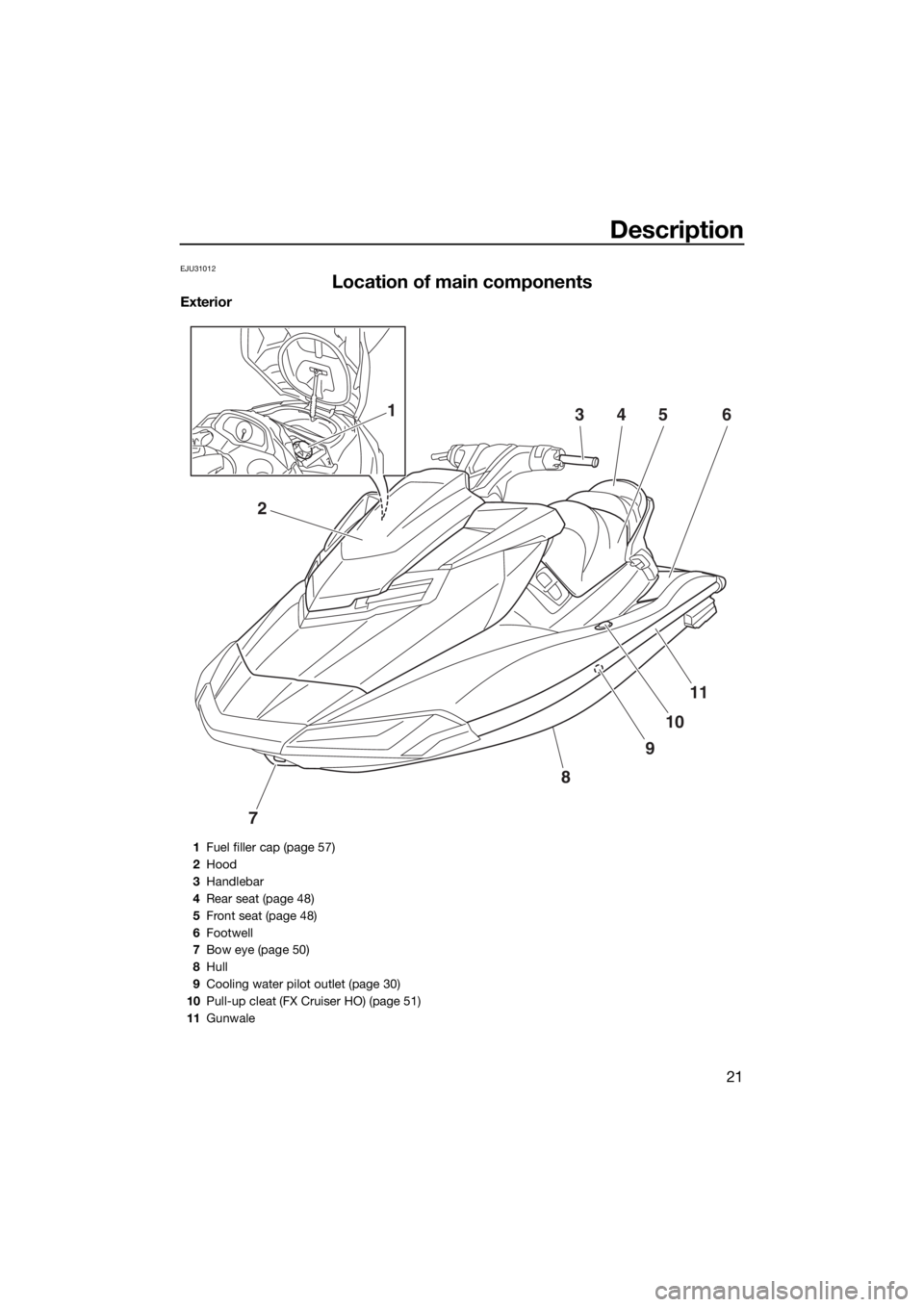
Description
21
EJU31012
Location of main components
Exterior
7
8
9
10
11
2
34561
1Fuel filler cap (page 57)
2Hood
3Handlebar
4Rear seat (page 48)
5Front seat (page 48)
6Footwell
7Bow eye (page 50)
8Hull
9Cooling water pilot outlet (page 30)
10Pull-up cleat (FX Cruiser HO) (page 51)
11Gunwale
UF2T78E0.book Page 21 Wednesday, July 12, 2017 9:40 AM
Page 30 of 116
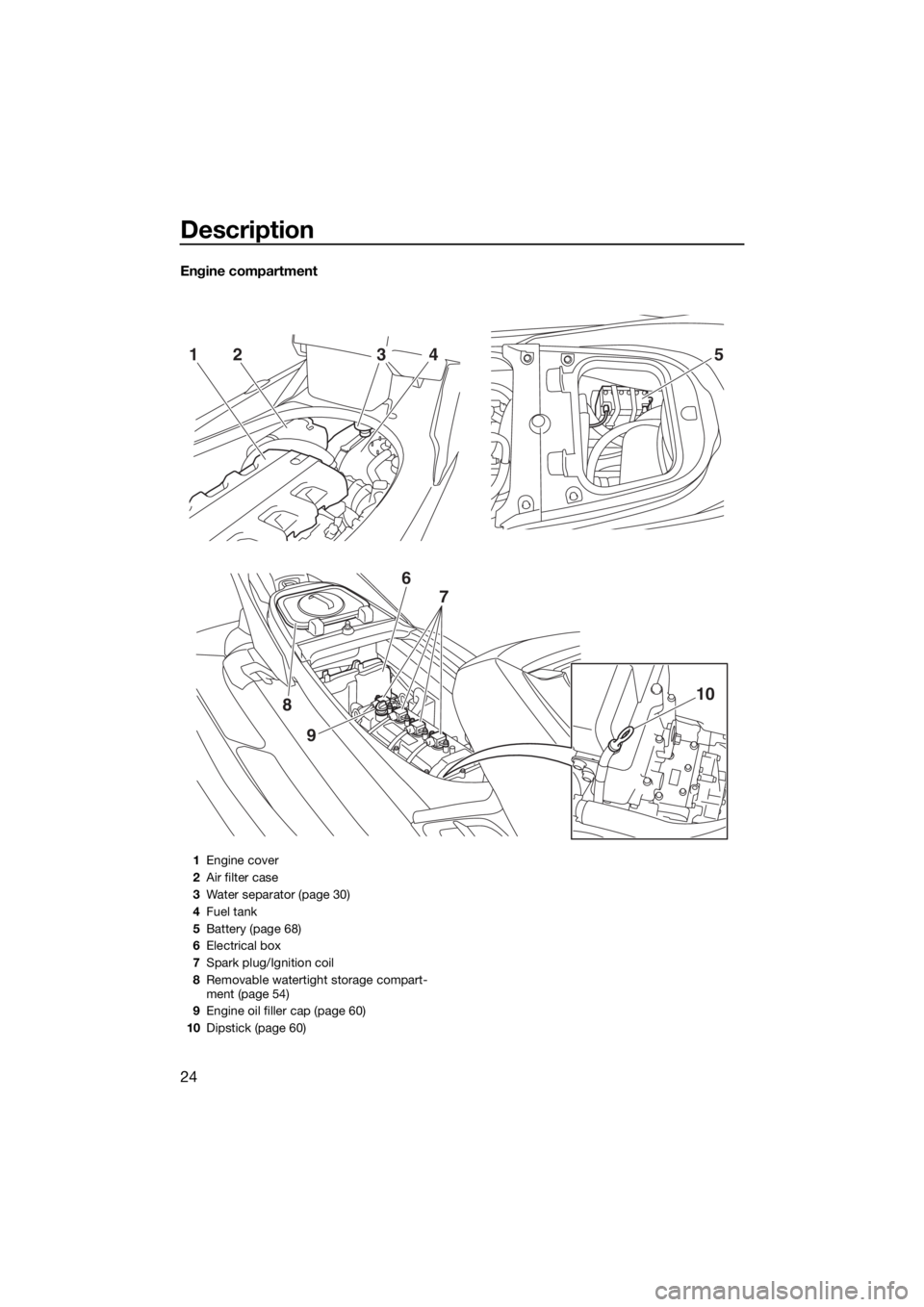
Description
24
Engine compartment
52143
9
8
6
7
10
1Engine cover
2Air filter case
3Water separator (page 30)
4Fuel tank
5Battery (page 68)
6Electrical box
7Spark plug/Ignition coil
8Removable watertight storage compart-
ment (page 54)
9Engine oil filler cap (page 60)
10Dipstick (page 60)
UF2T78E0.book Page 24 Wednesday, July 12, 2017 9:40 AM
Page 36 of 116
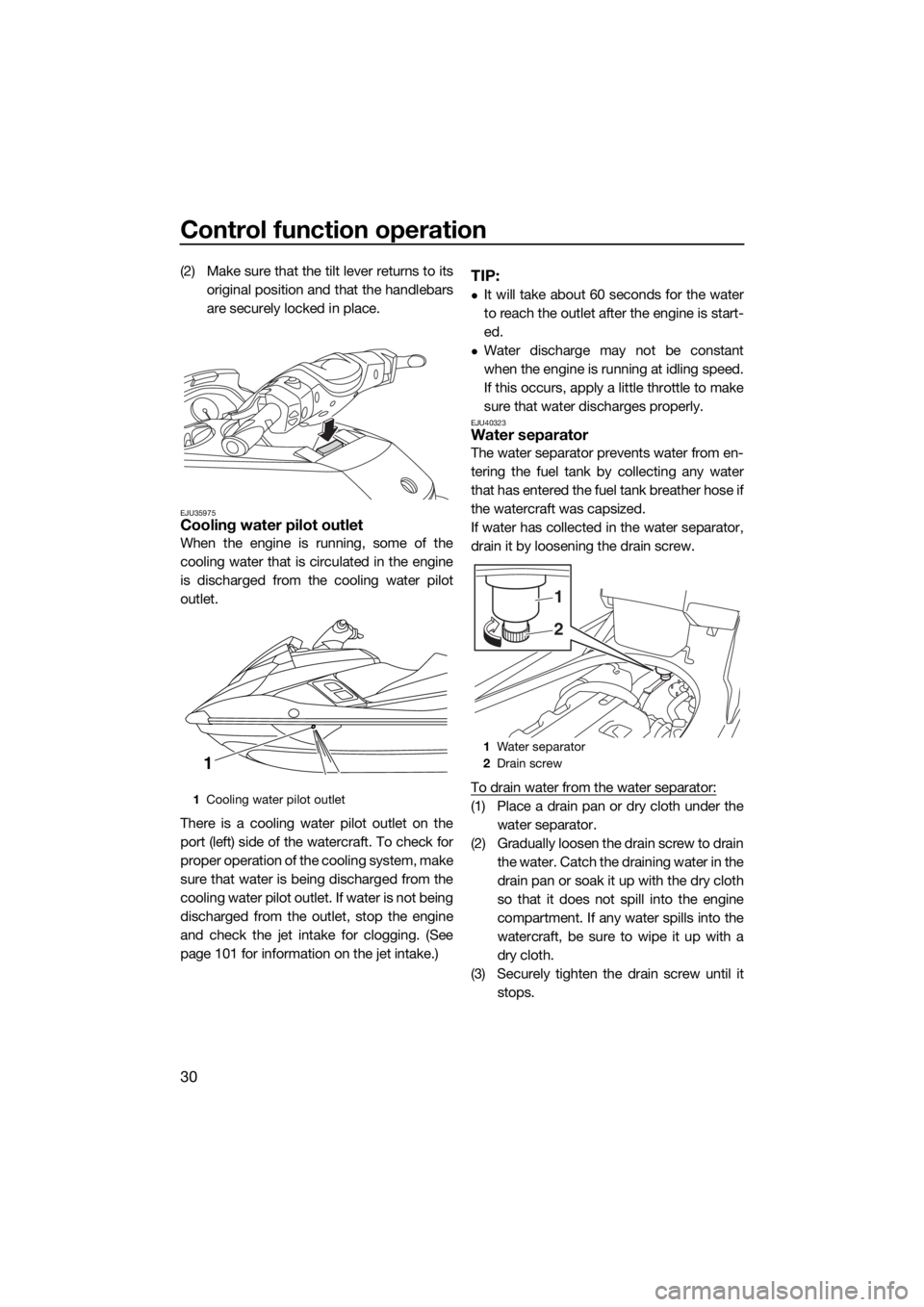
Control function operation
30
(2) Make sure that the tilt lever returns to its
original position and that the handlebars
are securely locked in place.
EJU35975Cooling water pilot outlet
When the engine is running, some of the
cooling water that is circulated in the engine
is discharged from the cooling water pilot
outlet.
There is a cooling water pilot outlet on the
port (left) side of the watercraft. To check for
proper operation of the cooling system, make
sure that water is being discharged from the
cooling water pilot outlet. If water is not being
discharged from the outlet, stop the engine
and check the jet intake for clogging. (See
page 101 for information on the jet intake.)
TIP:
It will take about 60 seconds for the water
to reach the outlet after the engine is start-
ed.
Water discharge may not be constant
when the engine is running at idling speed.
If this occurs, apply a little throttle to make
sure that water discharges properly.
EJU40323Water separator
The water separator prevents water from en-
tering the fuel tank by collecting any water
that has entered the fuel tank breather hose if
the watercraft was capsized.
If water has collected in the water separator,
drain it by loosening the drain screw.
To drain water from the water separator:
(1) Place a drain pan or dry cloth under the
water separator.
(2) Gradually loosen the drain screw to drain
the water. Catch the draining water in the
drain pan or soak it up with the dry cloth
so that it does not spill into the engine
compartment. If any water spills into the
watercraft, be sure to wipe it up with a
dry cloth.
(3) Securely tighten the drain screw until it
stops.1Cooling water pilot outlet
1
1Water separator
2Drain screw
2
1
UF2T78E0.book Page 30 Wednesday, July 12, 2017 9:40 AM
Page 64 of 116
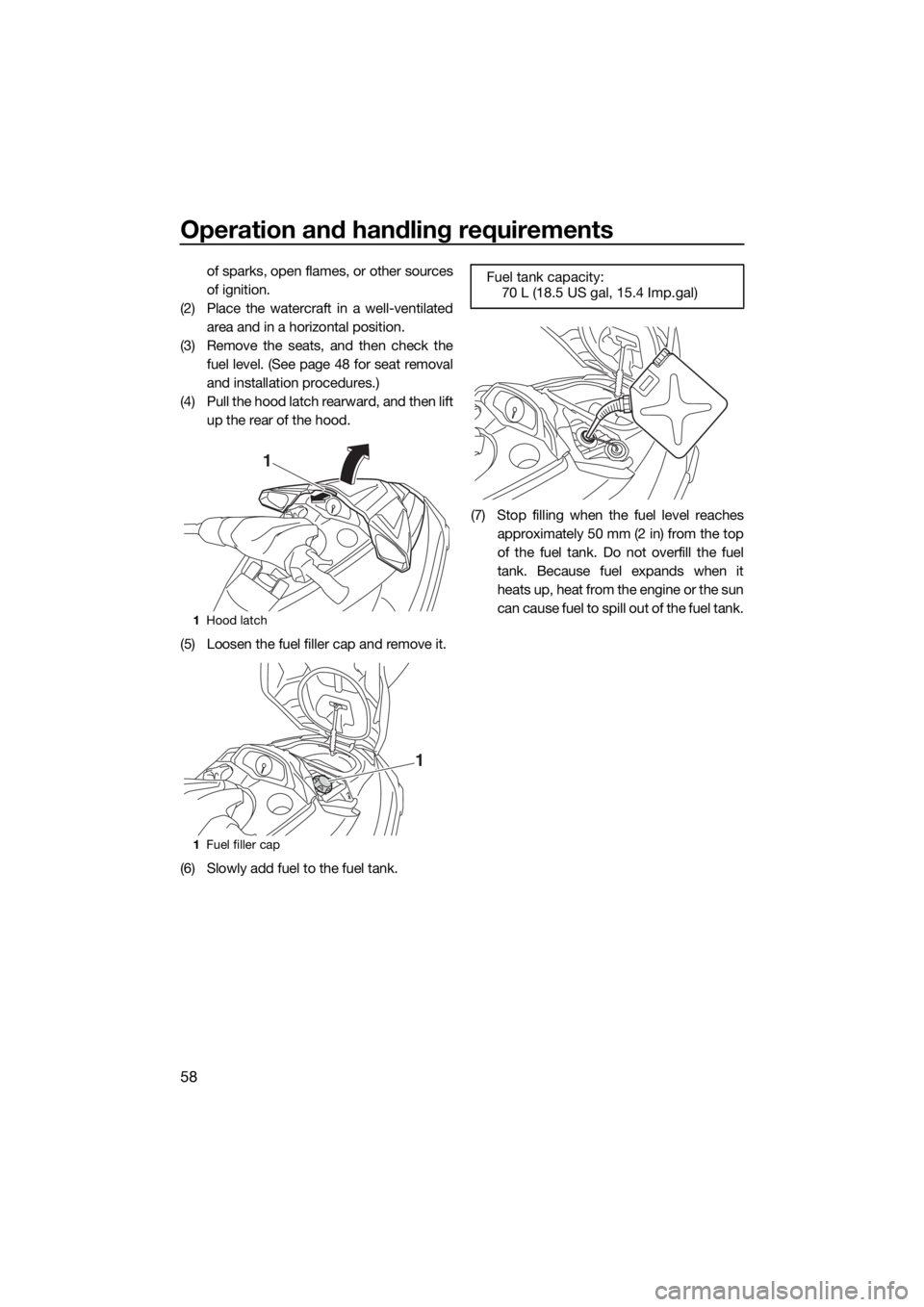
Operation and handling requirements
58
of sparks, open flames, or other sources
of ignition.
(2) Place the watercraft in a well-ventilated
area and in a horizontal position.
(3) Remove the seats, and then check the
fuel level. (See page 48 for seat removal
and installation procedures.)
(4) Pull the hood latch rearward, and then lift
up the rear of the hood.
(5) Loosen the fuel filler cap and remove it.
(6) Slowly add fuel to the fuel tank.(7) Stop filling when the fuel level reaches
approximately 50 mm (2 in) from the top
of the fuel tank. Do not overfill the fuel
tank. Because fuel expands when it
heats up, heat from the engine or the sun
can cause fuel to spill out of the fuel tank.
1Hood latch
1Fuel filler cap
1
1
Fuel tank capacity:
70 L (18.5 US gal, 15.4 Imp.gal)
UF2T78E0.book Page 58 Wednesday, July 12, 2017 9:40 AM
Page 65 of 116
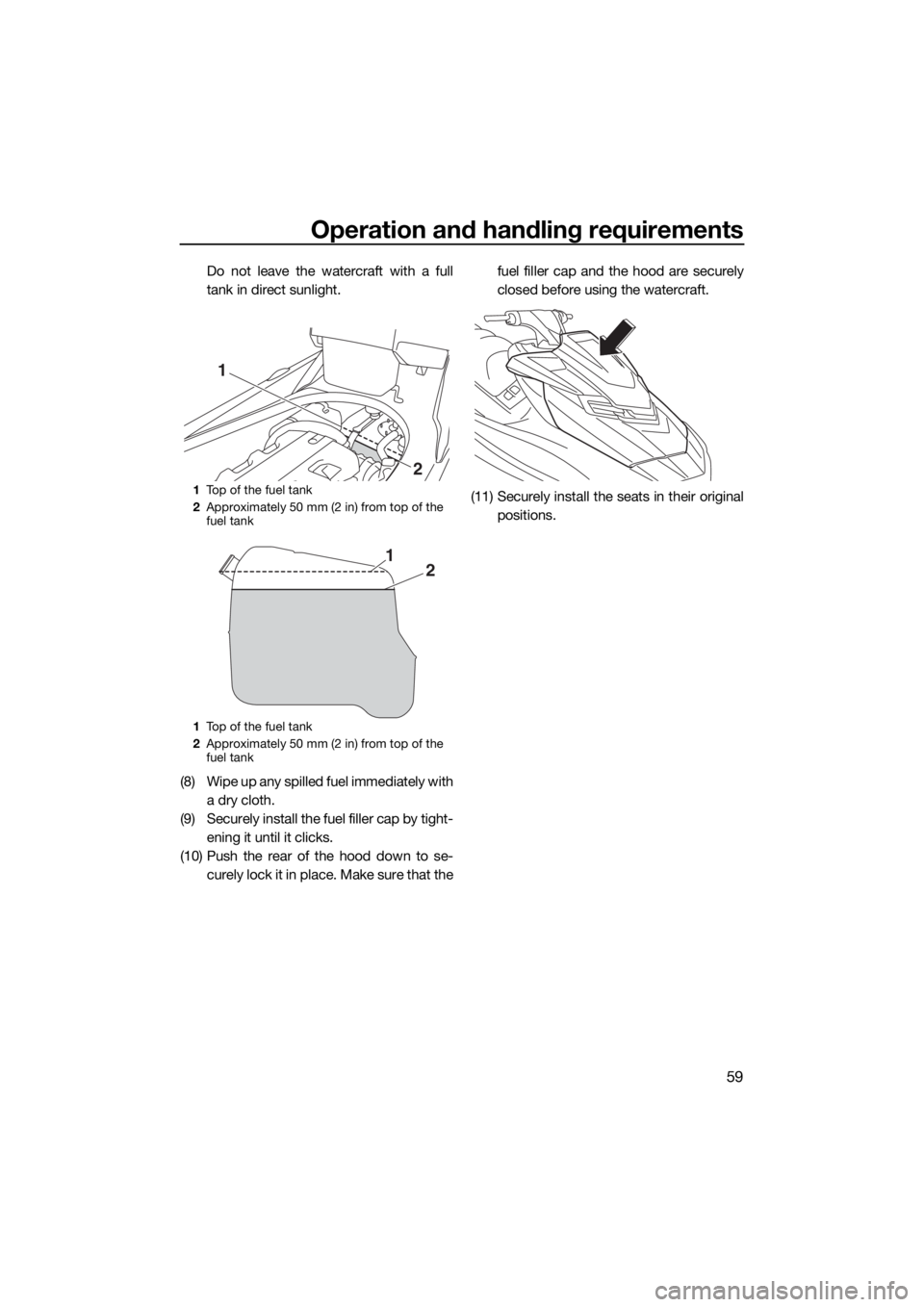
Operation and handling requirements
59
Do not leave the watercraft with a full
tank in direct sunlight.
(8) Wipe up any spilled fuel immediately with
a dry cloth.
(9) Securely install the fuel filler cap by tight-
ening it until it clicks.
(10) Push the rear of the hood down to se-
curely lock it in place. Make sure that thefuel filler cap and the hood are securely
closed before using the watercraft.
(11) Securely install the seats in their original
positions.
1Top of the fuel tank
2Approximately 50 mm (2 in) from top of the
fuel tank
1Top of the fuel tank
2Approximately 50 mm (2 in) from top of the
fuel tank
1
2
21
UF2T78E0.book Page 59 Wednesday, July 12, 2017 9:40 AM
Page 73 of 116
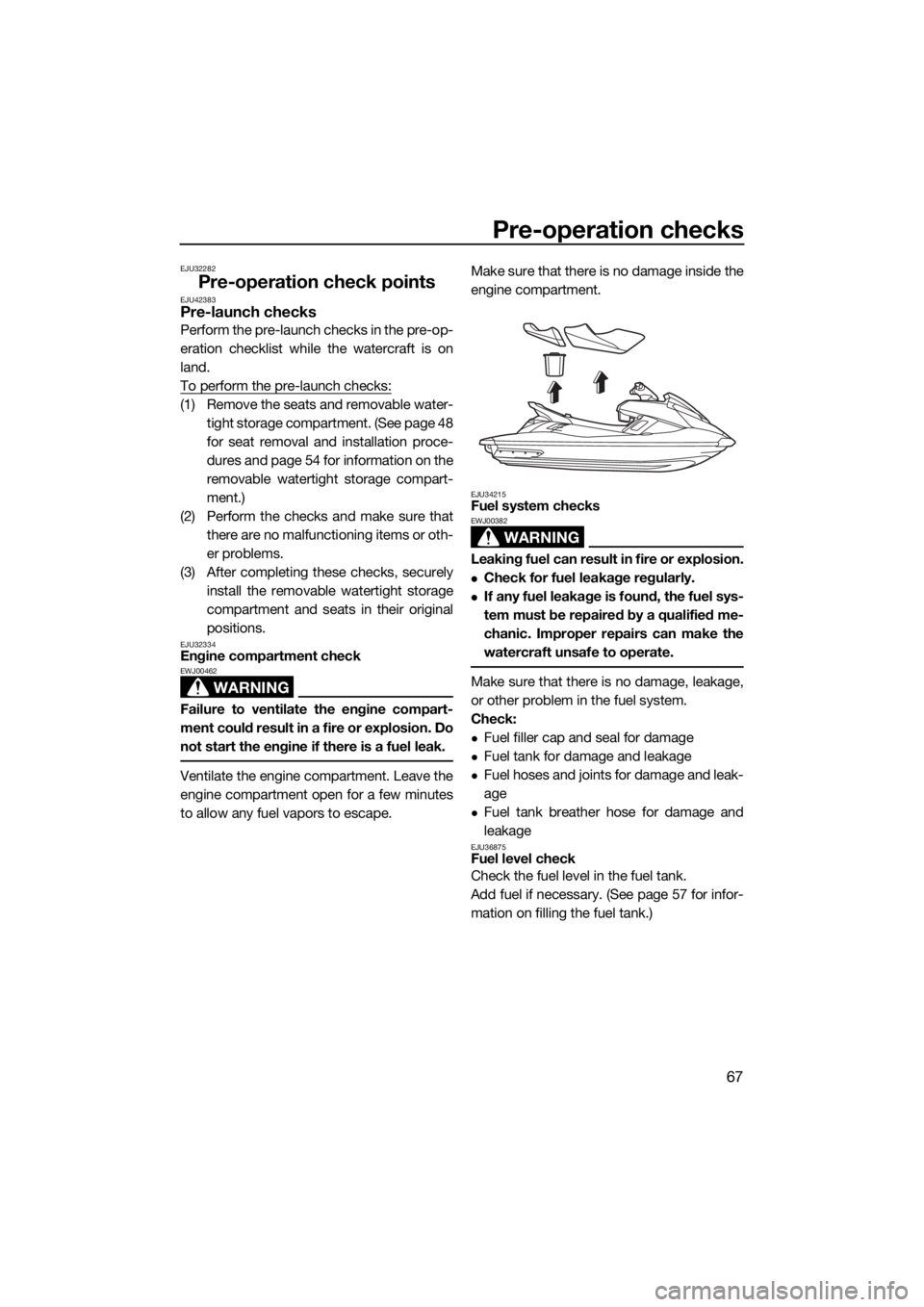
Pre-operation checks
67
EJU32282
Pre-operation check pointsEJU42383Pre-launch checks
Perform the pre-launch checks in the pre-op-
eration checklist while the watercraft is on
land.
To perform the pre-launch checks:
(1) Remove the seats and removable water-
tight storage compartment. (See page 48
for seat removal and installation proce-
dures and page 54 for information on the
removable watertight storage compart-
ment.)
(2) Perform the checks and make sure that
there are no malfunctioning items or oth-
er problems.
(3) After completing these checks, securely
install the removable watertight storage
compartment and seats in their original
positions.
EJU32334Engine compartment check
WARNING
EWJ00462
Failure to ventilate the engine compart-
ment could result in a fire or explosion. Do
not start the engine if there is a fuel leak.
Ventilate the engine compartment. Leave the
engine compartment open for a few minutes
to allow any fuel vapors to escape.Make sure that there is no damage inside the
engine compartment.
EJU34215Fuel system checks
WARNING
EWJ00382
Leaking fuel can result in fire or explosion.
Check for fuel leakage regularly.
If any fuel leakage is found, the fuel sys-
tem must be repaired by a qualified me-
chanic. Improper repairs can make the
watercraft unsafe to operate.
Make sure that there is no damage, leakage,
or other problem in the fuel system.
Check:
Fuel filler cap and seal for damage
Fuel tank for damage and leakage
Fuel hoses and joints for damage and leak-
age
Fuel tank breather hose for damage and
leakage
EJU36875Fuel level check
Check the fuel level in the fuel tank.
Add fuel if necessary. (See page 57 for infor-
mation on filling the fuel tank.)
UF2T78E0.book Page 67 Wednesday, July 12, 2017 9:40 AM
Page 93 of 116
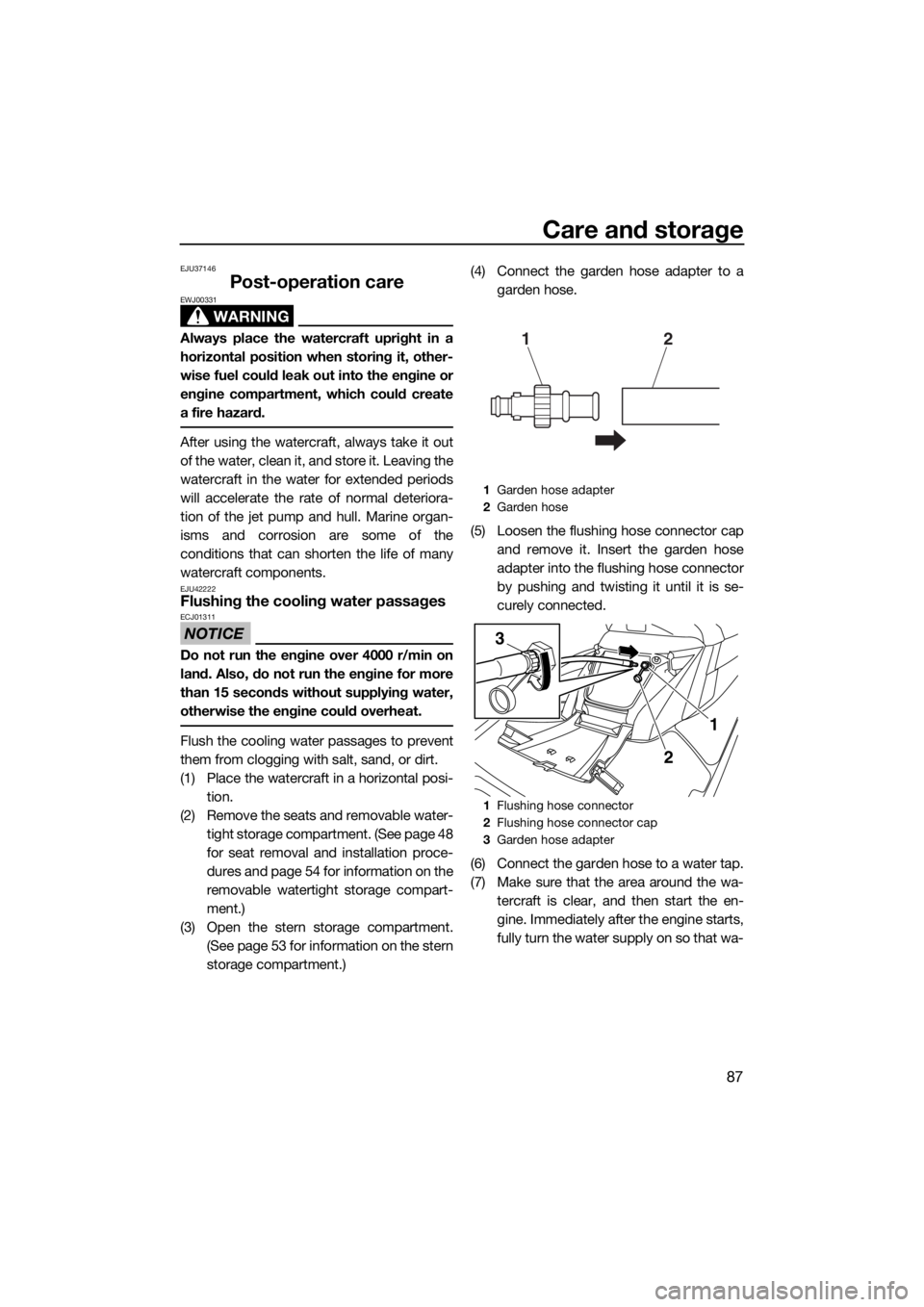
Care and storage
87
EJU37146
Post-operation care
WARNING
EWJ00331
Always place the watercraft upright in a
horizontal position when storing it, other-
wise fuel could leak out into the engine or
engine compartment, which could create
a fire hazard.
After using the watercraft, always take it out
of the water, clean it, and store it. Leaving the
watercraft in the water for extended periods
will accelerate the rate of normal deteriora-
tion of the jet pump and hull. Marine organ-
isms and corrosion are some of the
conditions that can shorten the life of many
watercraft components.
EJU42222Flushing the cooling water passages
NOTICE
ECJ01311
Do not run the engine over 4000 r/min on
land. Also, do not run the engine for more
than 15 seconds without supplying water,
otherwise the engine could overheat.
Flush the cooling water passages to prevent
them from clogging with salt, sand, or dirt.
(1) Place the watercraft in a horizontal posi-
tion.
(2) Remove the seats and removable water-
tight storage compartment. (See page 48
for seat removal and installation proce-
dures and page 54 for information on the
removable watertight storage compart-
ment.)
(3) Open the stern storage compartment.
(See page 53 for information on the stern
storage compartment.)(4) Connect the garden hose adapter to a
garden hose.
(5) Loosen the flushing hose connector cap
and remove it. Insert the garden hose
adapter into the flushing hose connector
by pushing and twisting it until it is se-
curely connected.
(6) Connect the garden hose to a water tap.
(7) Make sure that the area around the wa-
tercraft is clear, and then start the en-
gine. Immediately after the engine starts,
fully turn the water supply on so that wa-
1Garden hose adapter
2Garden hose
1Flushing hose connector
2Flushing hose connector cap
3Garden hose adapter
12
1
3
2
UF2T78E0.book Page 87 Wednesday, July 12, 2017 9:40 AM
Page 100 of 116
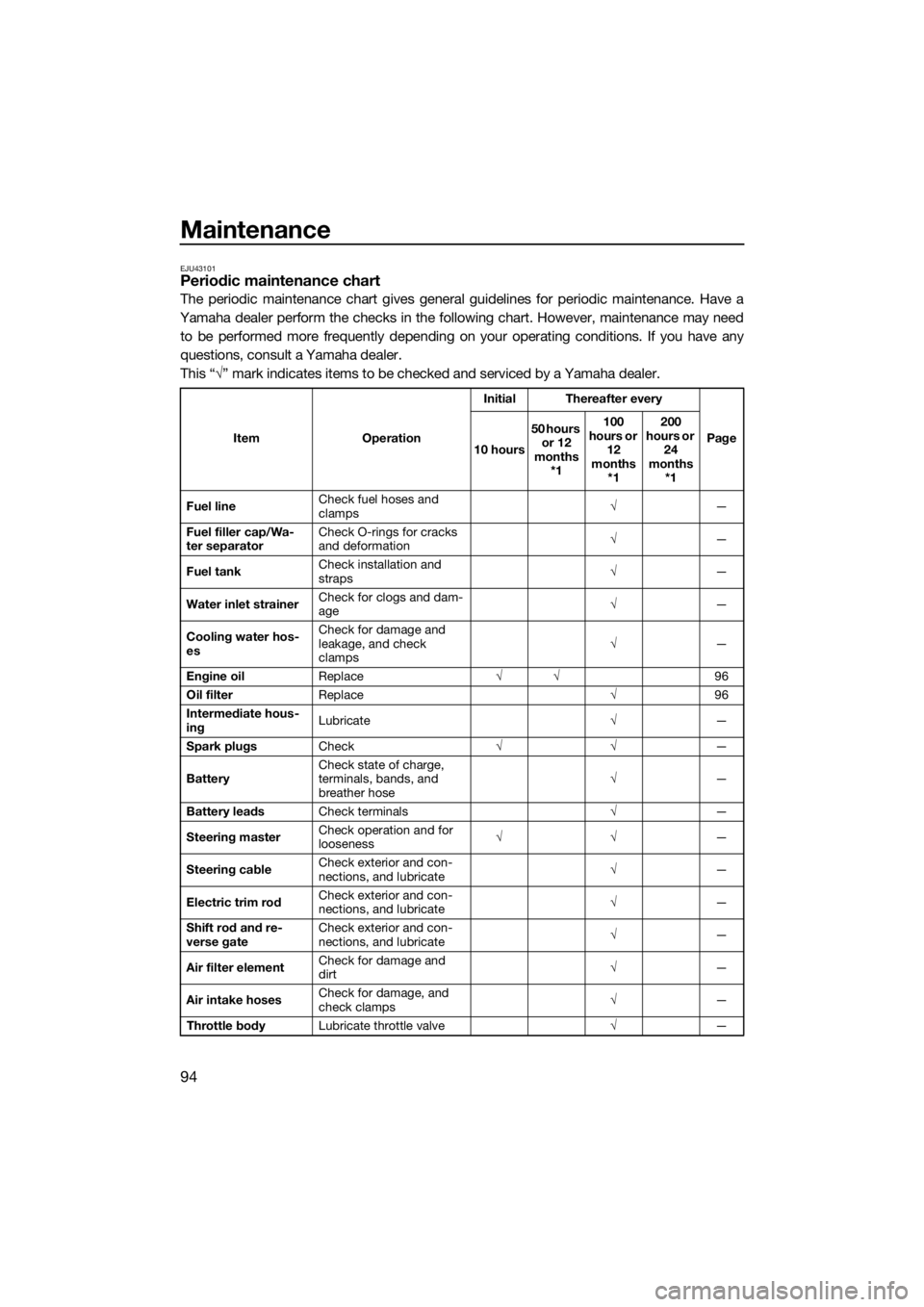
Maintenance
94
EJU43101Periodic maintenance chart
The periodic maintenance chart gives general guidelines for periodic maintenance. Have a
Yamaha dealer perform the checks in the following chart. However, maintenance may need
to be performed more frequently depending on your operating conditions. If you have any
questions, consult a Yamaha dealer.
This “√” mark indicates items to be checked and serviced by a Yamaha dealer.
Item OperationInitial Thereafter every
Page
10 hours50 hours
or 12
months
*1100
hours or
12
months
*1200
hours or
24
months
*1
Fuel lineCheck fuel hoses and
clamps√—
Fuel filler cap/Wa-
ter separatorCheck O-rings for cracks
and deformation√—
Fuel tankCheck installation and
straps√—
Water inlet strainerCheck for clogs and dam-
age√—
Cooling water hos-
esCheck for damage and
leakage, and check
clamps√—
Engine oilReplace√√96
Oil filterReplace√96
Intermediate hous-
ingLubricate√—
Spark plugsCheck√√—
BatteryCheck state of charge,
terminals, bands, and
breather hose√—
Battery leadsCheck terminals√—
Steering masterCheck operation and for
looseness√√—
Steering cableCheck exterior and con-
nections, and lubricate√—
Electric trim rodCheck exterior and con-
nections, and lubricate√—
Shift rod and re-
verse gate Check exterior and con-
nections, and lubricate√—
Air filter elementCheck for damage and
dirt√—
Air intake hosesCheck for damage, and
check clamps√
—
Throttle bodyLubricate throttle valve√—
UF2T78E0.book Page 94 Wednesday, July 12, 2017 9:40 AM
Page 103 of 116
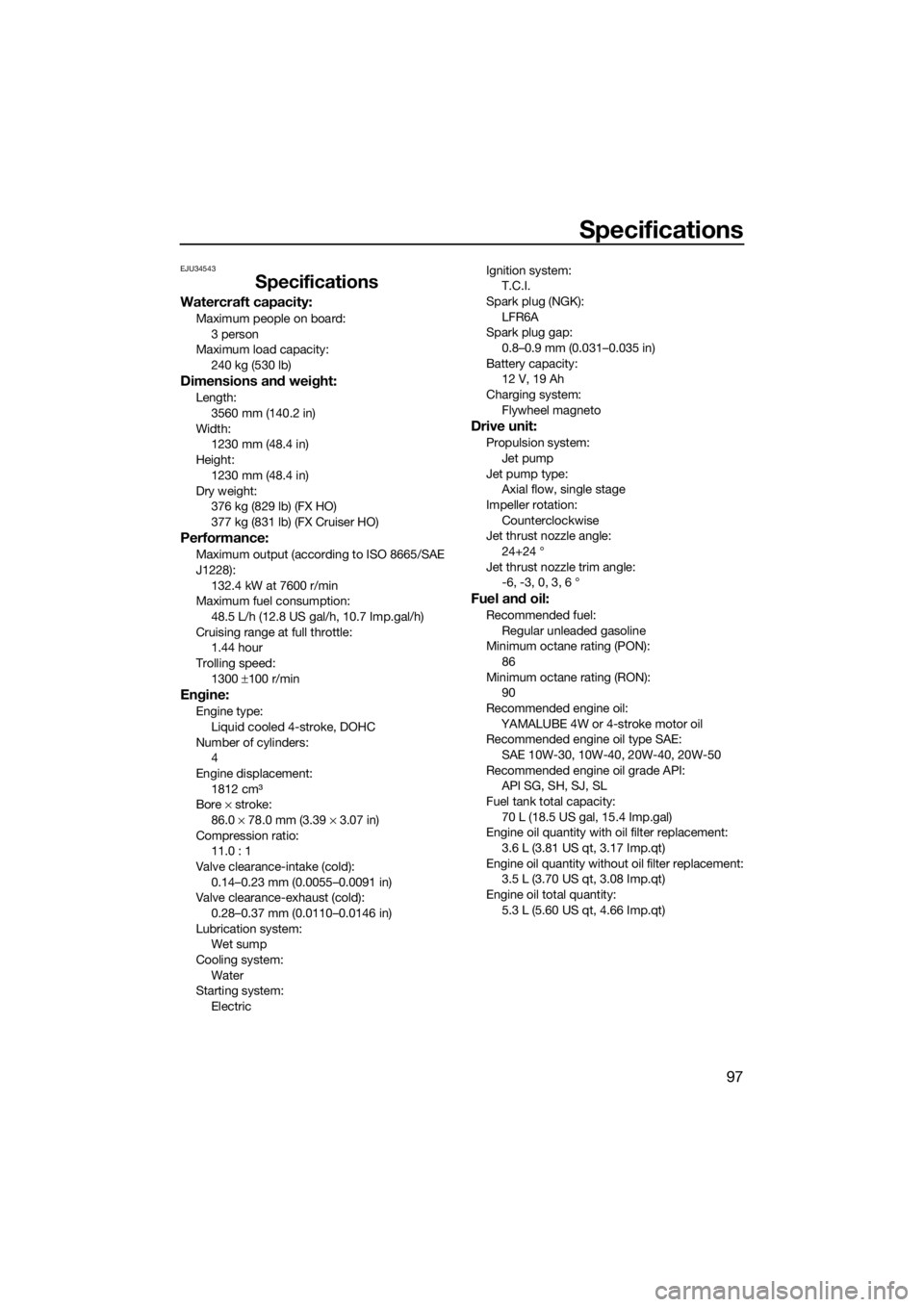
Specifications
97
EJU34543
Specifications
Watercraft capacity:
Maximum people on board:
3 person
Maximum load capacity:
240 kg (530 lb)
Dimensions and weight:
Length:
3560 mm (140.2 in)
Width:
1230 mm (48.4 in)
Height:
1230 mm (48.4 in)
Dry weight:
376 kg (829 lb) (FX HO)
377 kg (831 lb) (FX Cruiser HO)
Performance:
Maximum output (according to ISO 8665/SAE
J1228):
132.4 kW at 7600 r/min
Maximum fuel consumption:
48.5 L/h (12.8 US gal/h, 10.7 Imp.gal/h)
Cruising range at full throttle:
1.44 hour
Trolling speed:
1300 ±100 r/min
Engine:
Engine type:
Liquid cooled 4-stroke, DOHC
Number of cylinders:
4
Engine displacement:
1812 cm³
Bore × stroke:
86.0 × 78.0 mm (3.39 × 3.07 in)
Compression ratio:
11.0 : 1
Valve clearance-intake (cold):
0.14–0.23 mm (0.0055–0.0091 in)
Valve clearance-exhaust (cold):
0.28–0.37 mm (0.0110–0.0146 in)
Lubrication system:
Wet sump
Cooling system:
Water
Starting system:
ElectricIgnition system:
T.C.I.
Spark plug (NGK):
LFR6A
Spark plug gap:
0.8–0.9 mm (0.031–0.035 in)
Battery capacity:
12 V, 19 Ah
Charging system:
Flywheel magneto
Drive unit:
Propulsion system:
Jet pump
Jet pump type:
Axial flow, single stage
Impeller rotation:
Counterclockwise
Jet thrust nozzle angle:
24+24 °
Jet thrust nozzle trim angle:
-6, -3, 0, 3, 6 °
Fuel and oil:
Recommended fuel:
Regular unleaded gasoline
Minimum octane rating (PON):
86
Minimum octane rating (RON):
90
Recommended engine oil:
YAMALUBE 4W or 4-stroke motor oil
Recommended engine oil type SAE:
SAE 10W-30, 10W-40, 20W-40, 20W-50
Recommended engine oil grade API:
API SG, SH, SJ, SL
Fuel tank total capacity:
70 L (18.5 US gal, 15.4 Imp.gal)
Engine oil quantity with oil filter replacement:
3.6 L (3.81 US qt, 3.17 Imp.qt)
Engine oil quantity without oil filter replacement:
3.5 L (3.70 US qt, 3.08 Imp.qt)
Engine oil total quantity:
5.3 L (5.60 US qt, 4.66 Imp.qt)
UF2T78E0.book Page 97 Wednesday, July 12, 2017 9:40 AM
Page 113 of 116
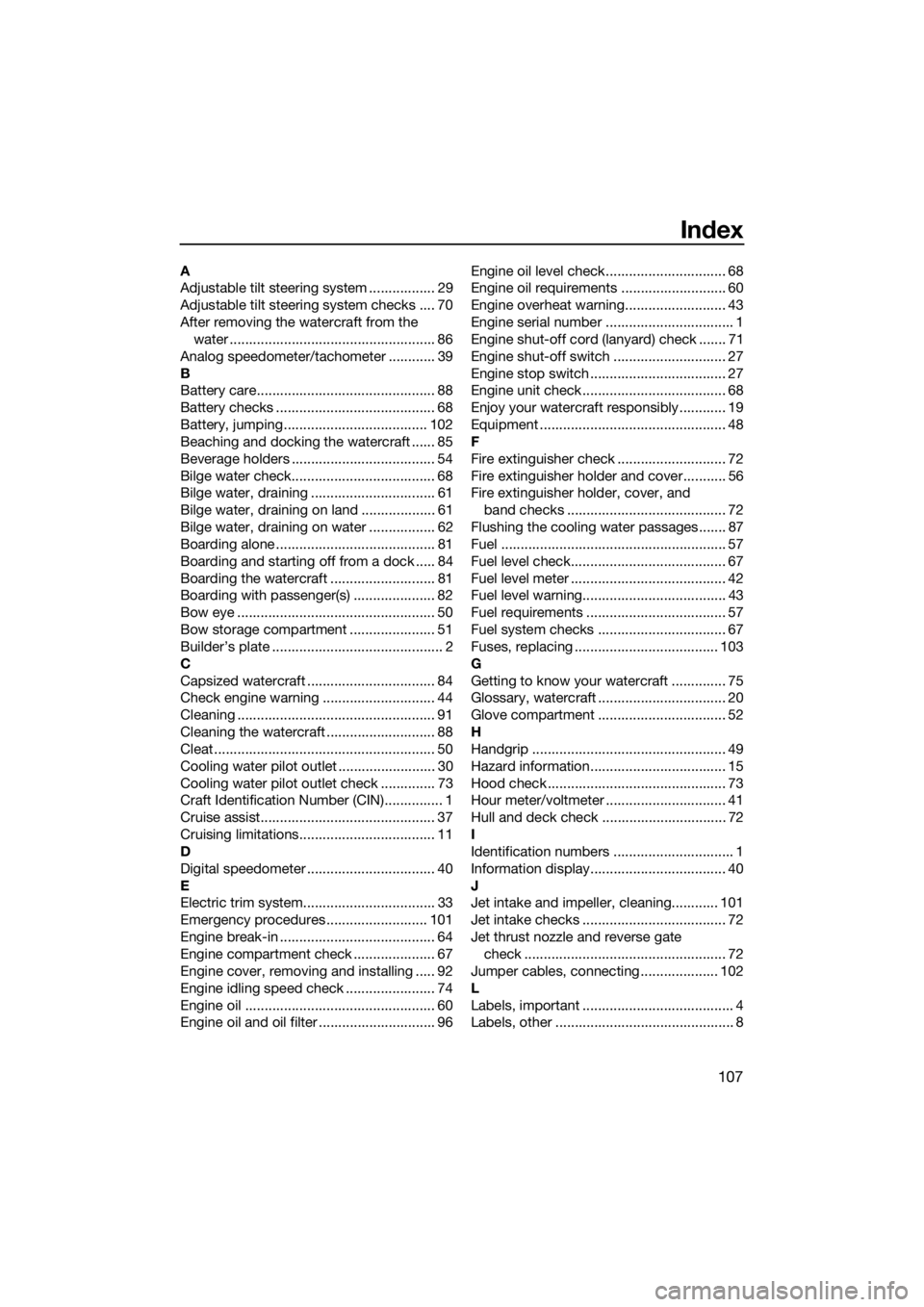
107
Index
A
Adjustable tilt steering system ................. 29
Adjustable tilt steering system checks .... 70
After removing the watercraft from the
water ..................................................... 86
Analog speedometer/tachometer ............ 39
B
Battery care.............................................. 88
Battery checks ......................................... 68
Battery, jumping ..................................... 102
Beaching and docking the watercraft ...... 85
Beverage holders ..................................... 54
Bilge water check..................................... 68
Bilge water, draining ................................ 61
Bilge water, draining on land ................... 61
Bilge water, draining on water ................. 62
Boarding alone ......................................... 81
Boarding and starting off from a dock ..... 84
Boarding the watercraft ........................... 81
Boarding with passenger(s) ..................... 82
Bow eye ................................................... 50
Bow storage compartment ...................... 51
Builder’s plate ............................................ 2
C
Capsized watercraft ................................. 84
Check engine warning ............................. 44
Cleaning ................................................... 91
Cleaning the watercraft ............................ 88
Cleat ......................................................... 50
Cooling water pilot outlet ......................... 30
Cooling water pilot outlet check .............. 73
Craft Identification Number (CIN)............... 1
Cruise assist............................................. 37
Cruising limitations................................... 11
D
Digital speedometer ................................. 40
E
Electric trim system.................................. 33
Emergency procedures .......................... 101
Engine break-in ........................................ 64
Engine compartment check ..................... 67
Engine cover, removing and installing ..... 92
Engine idling speed check ....................... 74
Engine oil ................................................. 60
Engine oil and oil filter .............................. 96Engine oil level check ............................... 68
Engine oil requirements ........................... 60
Engine overheat warning.......................... 43
Engine serial number ................................. 1
Engine shut-off cord (lanyard) check ....... 71
Engine shut-off switch ............................. 27
Engine stop switch ................................... 27
Engine unit check ..................................... 68
Enjoy your watercraft responsibly ............ 19
Equipment ................................................ 48
F
Fire extinguisher check ............................ 72
Fire extinguisher holder and cover........... 56
Fire extinguisher holder, cover, and
band checks ......................................... 72
Flushing the cooling water passages....... 87
Fuel .......................................................... 57
Fuel level check........................................ 67
Fuel level meter ........................................ 42
Fuel level warning..................................... 43
Fuel requirements .................................... 57
Fuel system checks ................................. 67
Fuses, replacing ..................................... 103
G
Getting to know your watercraft .............. 75
Glossary, watercraft ................................. 20
Glove compartment ................................. 52
H
Handgrip .................................................. 49
Hazard information................................... 15
Hood check .............................................. 73
Hour meter/voltmeter ............................... 41
Hull and deck check ................................ 72
I
Identification numbers ............................... 1
Information display................................... 40
J
Jet intake and impeller, cleaning............ 101
Jet intake checks ..................................... 72
Jet thrust nozzle and reverse gate
check .................................................... 72
Jumper cables, connecting .................... 102
L
Labels, important ....................................... 4
Labels, other .............................................. 8
UF2T78E0.book Page 107 Wednesday, July 12, 2017 9:40 AM